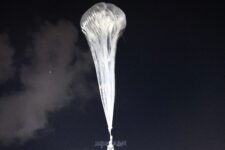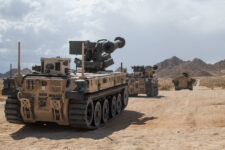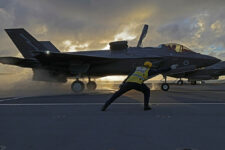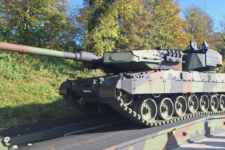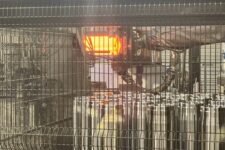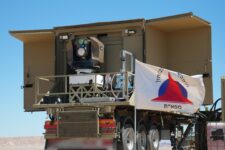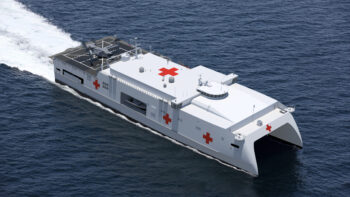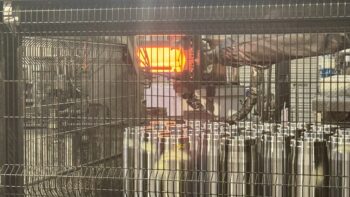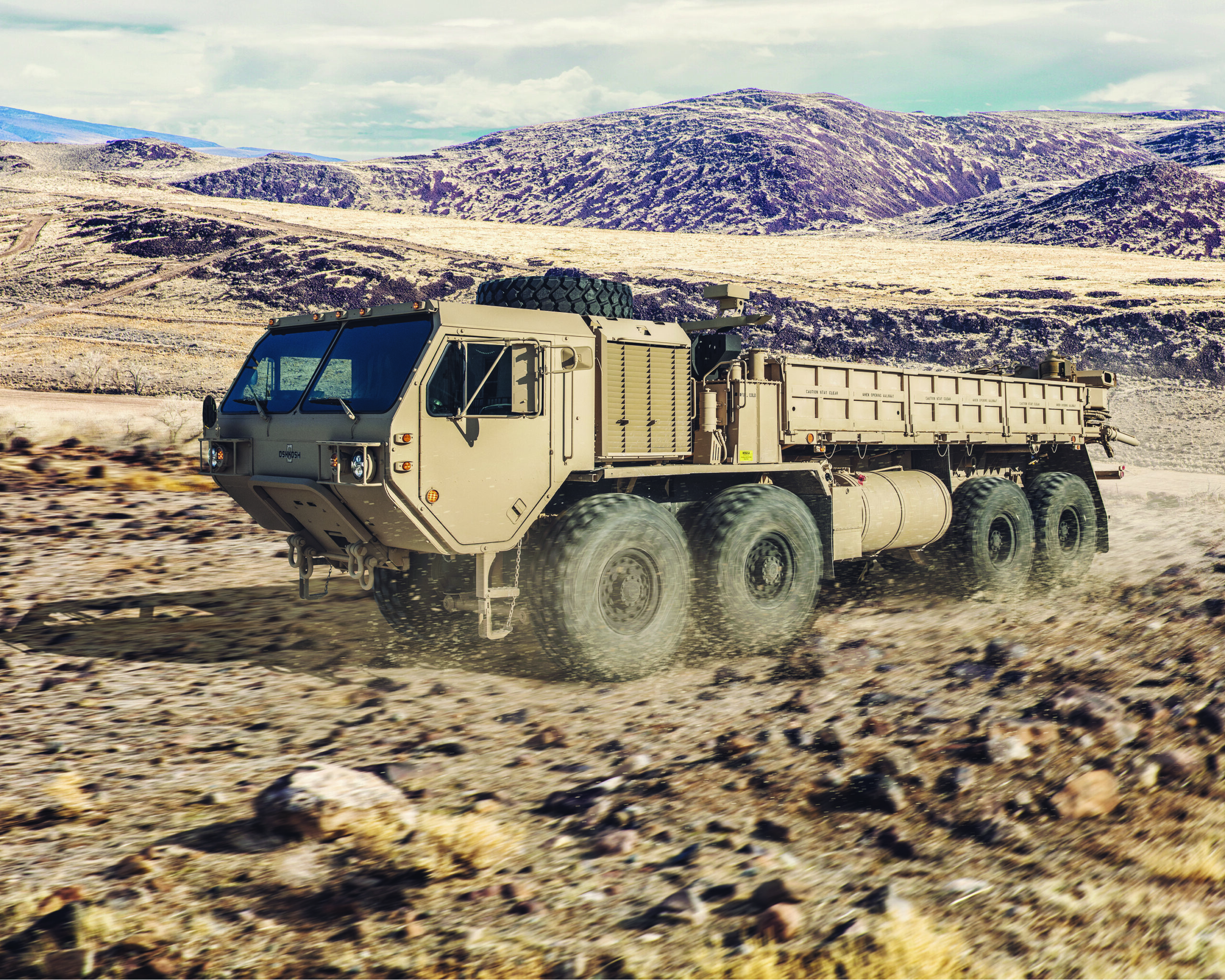
Oshkosh Defense HEMTT Guided Missile Transporter. Image courtesy of Oshkosh Defense.
The continued conflict in Ukraine underscores the pivotal role that logistics play and the value of being able to swiftly deploy to challenging and inaccessible locations. A recent article by the Atlantic Council military fellows stated, “the race to resupply troops at the frontlines remains the linchpin for military success on both sides.”
The vehicles carrying out these missions are specifically designed to meet stringent military requirements and survive the rigors of modern combat, including the most extreme conditions on the harshest terrains.
As defense vehicle acquisition strategies evolve and place greater focus on incorporating commercial automotive components, it is critical to remember these are the vehicles transporting and shielding our Warfighters on the battlefield. There is no question that improving technology is essential, but it is also vital that our Warfighters get nothing less than the best when it comes to tactical wheeled vehicles designed to complete their missions and come home safely.
Progress without sacrifice
The emphasis on lower procurement costs and integrating new technologies is not new for the U.S. Army. For decades, the Army has required vehicles to be modernized to support current and future missions. The Oshkosh Defense Heavy Expanded Mobility Tactical Truck (HEMTT) and Palletized Load System (PLS) are prime examples. Each platform has multiple variants that have been consistently modernized over their life cycles to incorporate new and advanced technologies. This includes integrating new payloads with more room to grow, offering the flexibility to fit virtually any mission profile and accommodate multi-domain operations.

Oshkosh Defense HEMTT Terminal High Altitude Area Defense (THADD). Image courtesy of Oshkosh Defense.
Historically thought of as logistics vehicles only, the HEMTT and PLS regularly serve as enablers for full scale combat operations against near peer threats. The HEMTT Terminal High Altitude Area Defense (THAAD) is a key system for defending against short and medium-range ballistic missiles and protecting civilians and military allies. Additional defense integrations on Oshkosh heavy vehicle platforms include HEMTT High Energy Laser (HEL), HEMTT Patriot, HEMTT Guided Missile Transporter (GMT), HEMTT Common Bridge Transporter (CBT), Multiple Launcher Rocket System (MLRS), Naval Strike Missile, or Harpoon, and the Mobile Artillery Platform (MAP).
“Flexible architecture allows significant room for growth as both threats and requirements evolve,” said Pat Williams, chief programs officer, Oshkosh Defense. “Adaptability is key to these heavy platforms providing the payload, protection, and mobility to support combat formations in the most demanding current and future combat environments.”
Recapitalization: Extending vehicle life at a fraction of the cost
Since 1995, the U.S. Army has looked to Oshkosh Defense recapitalization services to upgrade the HEMTT and PLS with the latest technology and safety features. Heavily used vehicles are returned to Oshkosh, stripped to the frame rails, and completely rebuilt to zero-mile, zero-hour condition on the same production lines as a new vehicle. With an average cost savings of 19% compared to a new vehicle, recapitalization is key to extending vehicle life, reducing operating costs, improving reliability, and enhancing capabilities. Recapitalization is utilized today and can continue to be used as a cost-effective way to modernize the future fleet with new and upgraded technologies.
Results from recapitalization include better troop protection, improved suspension and mobility, electrical updates, and additional Soldier safety features. It has also provided an incremental approach to modernization as technologies advance and change over time. Through the recapitalization process, vehicles are returned to field operations with the same warranty and life cycle cost advantages of a brand-new vehicle. Since recapitalization began, almost 41% of existing HEMTTs and 45% of PLS trucks have been modernized through recapitalization.
Innovation driven
The U.S. Army and Oshkosh continue to work together to equip the HEMTT and PLS with advanced driver assistance features such as electronic stability control, lane departure warning, and collision mitigation breaking – the same estate-of-the-art automotive technology you would find in your vehicle at home.
“For more than twenty years, Oshkosh has prioritized investments in developing and integrating various electrification systems including diesel-electric, hybrid, and battery electric vehicle (BEV) solutions to reduce fuel consumption for several tactical wheel vehicles,” said Jeffry Heggemeier, vice president – engineering, Oshkosh Defense. “Pioneering new ways to design, test and refine technologies is the Oshkosh way of moving industries forward.”
In 2017, Oshkosh Defense was awarded a contract to aid in the development and integration of the Tactical Vehicle Electrification Kit (TVEK). The TVEK project was created to develop, evaluate, and demonstrate a fiscally responsible tactical vehicle electrification system that would significantly reduce fuel consumption for HEMTT A4 platforms. The TVEK can also enable external power connectivity, provide power import and export capabilities, and further reduce petroleum use when electrical supply is abundant and available. Results of the TVEK project were exceptional, proving a 22% reduction in fuel use and 56% reduction in overall engine run time. Oshkosh has since implemented learnings from the TVEK project into other vehicles.
“The advanced architecture of these vehicles allows for seamless integration of additional features, such as drive by wire capability, Condition Based Maintenance (CBM), electrification, export power, fuel efficiency and demand reduction modifications,” continued Heggemeier.
Oshkosh continues to advance Prognostic and Predictive Maintenance through CBM and CBM+ technology to recommend optimized maintenance schedules and strategies. Continually assessing actual vehicle condition through sensors, observations, and portable devices, provides recommendations for evidence-based maintenance which further reduces life cycle costs and improves readiness.

Mobile Artillery Platform (MAP). Image courtesy of Oshkosh Defense.
Battle-tested and ready for combat – now
Built by the premier tactical wheeled vehicle manufacturer for the U.S. Military, the HEMTT and PLS are engineered to surmount the toughest environments – on and off the battlefield. Proven in the crucible of modern combat, they have saved many lives while accomplishing the toughest missions.
Unmatched payloads allow for the hauling of rocket launchers, missile defense systems and other mission-critical equipment. The HEMTT and PLS both showcase weapon systems and advanced technologies that support Missile Defense, Long Range Precision Fires, and Anti-Ship missions.
COTS offers benefits
To minimize procurement and lifecycle costs, the HEMTT and PLS are built with commercial automotive components such engine, transmission, wheels, and tires.
“A common misconception is that the current FHTV fleet lacks commercial components,” Williams stated. “In fact, the majority of the parts installed on the PLS and HEMTT vehicles are COTS or COTS tailored to meet military specifications. From a design standpoint, this allows for maximum component commonality and minimal change when creating new variants or adding new capabilities or technical insertions.”
According to Defense Acquisition University, the primary benefits of using COTS components on system design are to reduce development time, allow faster insertion of new technology, and lower life-cycle costs by taking advantage of a more readily available and up-to-date commercial industrial base.
Commonality increases operational flexibility
A flexible architecture results in the ability to scale up or down with minimal changes to the HEMTT and PLS vehicles.
The HEMTT and PLS support more than a dozen variant and integration options, utilizing common armor packages to ensure a superior level of protection that can accommodate nearly any mission.
The current HEMTT vehicles are over 90% common with each model within the fleet, and the PLS fleet is approximately 55% common with the HEMTT fleet. The level of commonality benefits seen across vehicle platforms not only applies to the parts on the vehicle – but also the familiarity of operations, training, maintenance, and support activities, all of which offer significant cost benefits. The end user also realizes a cost savings through a smaller logistics and spares footprint, and a reduction in lead-time associated with product upgrades or modifications.
Next-gen technology, decades of dependability
Oshkosh Defense was first awarded the HEMTT contract in 1981 and the PLS in 1990. In nearly 50 years, Oshkosh has built almost 36,000 HEMTTs and over 8,500 PLS trucks that continue to deliver exceptional performance during the most difficult missions. A dependable network of suppliers allows for evolving production that meets the demands of the U.S. Military.
Designed with the highest regard for the Warfighter and future battlefield, it is never a choice between advanced technology, or a vehicle designed for the extreme demands of combat operations.
Backed by the significant commercial experience of Oshkosh Corporation, Oshkosh Defense has the distinct advantage of tailoring commercial technology to meet the unique demands of U.S. Military requirements. Oshkosh Corporation continues to innovate and design with the future in mind, creating AI-enabled products, active safety features, electrification, and other advanced technologies capable of moving industries forward.
Today’s constantly evolving military threats require heavy tactical vehicles that can keep pace with the changing battlefield. The Oshkosh Defense HEMTT and PLS proven capabilities and reputation remains strong to this day. Serving countries all over the world in times of crisis and conflict, these Oshkosh vehicles continuously prove their capability of delivering performance and reliability.
Williams concludes, “Whether hauling lifesaving supplies or engaged in a firefight, our Warfighters require proven and battle-tested vehicles. Moving troops and materials to and through the battlefield is critical to the success of any mission, which is why the Department of Defense continues to rely on Oshkosh Defense to provide the most versatile, capable, and proven tactical wheeled vehicles in the industry.”
